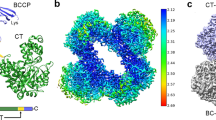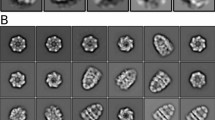Abstract
The chaperonin GroEL binds nonnative substrate protein in the hydrophobic central cavity of an open ring. ATP and GroES binding to the same ring converts this cavity into an encapsulated, hydrophilic chamber that mediates productive folding. A 'rack' mechanism of initial protein unfolding proposes that, upon GroES and ATP binding, the polypeptide is stretched between the binding sites on the twisting apical domains of GroEL before complete release into the chamber. Here, the structure of malate dehydrogenase (MDH) subunit during folding is monitored by deuterium exchange, peptic fragment production and mass spectrometry. When bound to GroEL, MDH exhibits a core of partially protected secondary structure that is only modestly deprotected upon ATP and GroES binding. Moreover, deprotection is broadly distributed throughout MDH, suggesting that it results from breaking hydrogen bonds between MDH and the cavity wall or global destabilization, as opposed to forced mechanical unfolding.
This is a preview of subscription content, access via your institution
Access options
Subscribe to this journal
Receive 12 print issues and online access
$189.00 per year
only $15.75 per issue
Buy this article
- Purchase on Springer Link
- Instant access to full article PDF
Prices may be subject to local taxes which are calculated during checkout





Similar content being viewed by others
References
Sigler, P.B. et al. Structure and function in GroEL-mediated protein folding. Annu. Rev. Biochem. 67, 581–608 (1998).
Sparrer, H. & Buchner, J. How GroES regulates binding of nonnative protein to GroEL. J. Biol. Chem. 272, 14080–14086 (1997).
Rye, H.S. et al. GroEL–GroES cycling: ATP and nonnative polypeptide direct alternation of folding-active rings. Cell 97, 325–328 (1999).
Farr, G.W. et al. Multivalent binding of nonnative substrate proteins by the chaperonin GroEL. Cell 100, 561–573 (2000).
Zahn, R., Perrett, S., Stenberg, G. & Fersht, A.R. Catalysis of amide proton exchange by the molecular chaperones GroEL and SecB. Science 271, 642–645 (1996).
Zahn, R. & Plückthun, A. Thermodynamic partitioning model for hydrophobic binding of polypeptides by GroEL. II. GroEL recognizes thermally unfolded mature β-lactamase. J. Mol. Biol. 242, 165–174 (1994).
Walter, S., Lorimer, G.H. & Schmid, F.X. A thermodynamic coupling mechanism for GroEL-mediated unfolding. Proc. Natl. Acad. Sci. USA 93, 9425–9430 (1996).
Clark, A.C. & Frieden, C. The chaperonin GroEL binds to late-folding non-native conformations present in native Escherichia coli and murine dihyrofolate reductases. J. Mol. Biol. 285, 1777–1788 (1999).
Bhutani, N. & Udgaonkar, J.B. A thermodynamic coupling mechanism can explain the GroEL-mediated acceleration of the folding of barstar. J. Mol. Biol. 297, 1037–1044 (2000).
Weissman, J.S., Rye, H.S., Fenton, W.A., Beechem, J.M. & Horwich, A.L. Characterization of the active intermediate of a GroEL–GroES-mediated protein folding reaction. Cell 84, 481–490 (1996).
Rye, H.S. et al. Distinct actions of cis and trans ATP within the double ring of the chaperonin GroEL. Nature 388, 792–798 (1997).
Shtilerman, M., Lorimer, G.H. & Englander, S.W. Chaperonin function: folding by forced unfolding. Science 284, 822–825 (1999).
Miller, A.D., Maghlaoui K., Albanese, G., Kleinjan, D.A. & Smith, C. Escherichia coli chaperonins Cpn60 (groEL) and Cpn10 (groES) do not catalyse the refolding of mitochondrial malate dehydrogenase. Biochem. J. 291, 139–144 (1993).
Peralta, D., Hartman, D.J., Hoogenraad, N.J. & Hoj, P.B. Generation of a stable folding intermediate which can be rescued by the chaperonins GroEL and GroES. FEBS Lett. 339, 45–49 (1994).
Ranson, N.A., Dunster, N.J., Burston, S.G. & Clarke, A.R. Chaperonins can catalyze the reversal of early aggregation steps when a protein misfolds. J. Mol. Biol. 250, 581–586 (1995).
Weissman, J.S. et al. Mechanism of GroEL action: productive release of polypeptide from a sequestered position under GroES. Cell 83, 577–588 (1995).
Todd, M.J., Viitanen, P.V. & Lorimer, G.H. Dynamics of the chaperonin ATPase cycle: implications for facilitated protein folding. Science 265, 659–666 (1994).
Bai, Y., Milne, J.S., Mayne, L. & Englander, S.W. Primary structure effects on peptide group hydrogen exchange. Proteins Struct. Funct. Genet. 17, 75–86 (1993).
Ranson, N.A., Burston, S.G. & Clarke, A.R. Binding, encapsulation and ejection: substrate dynamics during a chaperonin-assisted folding reaction. J. Mol. Biol. 266, 656–664.
Zahn, R., Spitzfaden, C., Ottiger, M., Wüthrich, K. & Plückthun, A. Destabilization of the complete protein secondary structure on binding to the chaperone GroEL. Nature 368, 261–265 (1994).
Robinson, C.V. et al. Conformation of GroEL-bound α-lactalbumin probed by mass spectrometry. Nature 372, 646–651 (1994).
Groß, M., Robinson, C.V., Mayhew, M., Hartl, F.U. & Radford, S.E. Significant hydrogen exchange protection in GroEL-bound DHFR is maintained during iterative rounds of substrate cycling. Protein Sci. 5, 2506–2513.
Goldberg, M.S. et al. Native-like structure of a protein-folding intermediate bound to the chaperonin GroEL. Proc. Natl. Acad. Sci. USA 94, 1080–1085 (1997).
Gervasoni, P., Gehrig, P. & Pluckthun . Two conformational states of β-lactamase bound to GroEL: A biophysical characterization. J. Mol. Biol. 275, 663–675 (1998).
Buckle, A.M., Zahn, R. & Fersht, A.R. A structural model for GroEL-polypeptide recognition. Proc. Natl. Acad. Sci.USA 94, 3571–3575 (1997).
Chen, L. & Sigler, P.B. The crystal structure of a GroEL/peptide complex: plasticity as a basis for substrate diversity. Cell 99, 757–768 (1999).
Englander, J.J., Rogero, J.R. & Englander, S.W. Protein hydrogen exchange studied by the fragment separation method. Anal. Biochem. 147, 234–244 (1985).
Zhang, Z. & Smith, D.L. Determination of amide hydrogen exchange by mass spectrometry: a new tool for protein structure elucidation. Protein Sci. 2, 522–531 (1993).
Smith, D.L., Deng, Y. & Zhang, Z. Probing the noncovalent structure of proteins by amide hydrogen exchange and mass spectrometry. J. Mass. Spectrom. 32, 135–146 (1997).
Miranker, A., Robinson, C.V., Radford, S.E., Aplin, R.T. & Dobson, C.M. Detection of transient protein folding populations by mass spectrometry. Science 262, 896–900 (1993).
Zhang, Z., Post, C.B. & Smith, D.L. Amide hydrogen exchange determined by mass spectrometry: application to rabbit muscle aldolase. Biochemistry 35, 779–791 (1996).
Gleason, W.B., Fu, Z., Birktoft, J. & Banaszak, L. Refined crystal structure of mitochondrial malate dehydrogenase from porcine heart and the consensus structure for dicarboxylic acid oxidoreductases. Biochemistry 33, 2078–2088 (1994).
Kraulis, P.J. Molscript: A program to produce both detailed and schematic plots of protein structures. J. Appl. Crystallogr. 24, 946–950 (1991).
Acknowledgements
This work was supported by grants from the NIH, the Nebraska Center for Mass Spectrometry and the Howard Hughes Medical Institute. We thank members of the Horwich lab for helpful discussion and W. Fenton for critical reading of the manuscript.
Author information
Authors and Affiliations
Corresponding author
Rights and permissions
About this article
Cite this article
Chen, J., Walter, S., Horwich, A. et al. Folding of malate dehydrogenase inside the GroEL–GroES cavity. Nat Struct Mol Biol 8, 721–728 (2001). https://doi.org/10.1038/90443
Received:
Accepted:
Issue Date:
DOI: https://doi.org/10.1038/90443
This article is cited by
-
Crucial HSP70 co-chaperone complex unlocks metazoan protein disaggregation
Nature (2015)
-
Hydrogen Exchange Mass Spectrometry: Are We Out of the Quicksand?
Journal of the American Society for Mass Spectrometry (2012)
-
Reconciling theories of chaperonin accelerated folding with experimental evidence
Cellular and Molecular Life Sciences (2010)
-
GroEL-induced topological dislocation of a substrate protein β-sheet core: a solution EPR spin–spin distance study
Journal of Chemical Biology (2010)
-
GroEL stimulates protein folding through forced unfolding
Nature Structural & Molecular Biology (2008)



